Greater White-fronted Goose
- February 21, 2024
- 0 comment
The Greater White-fronted Goose, scientifically known as Anser albifrons, is a captivating waterfowl species renowned for its distinctive appearance and remarkable migratory behavior. These geese are characterized by their brownish-gray bodies adorned with white patches on their faces surrounding the bill, giving them their distinctive name. With orange legs and pinkish bills featuring black tips, they present a striking sight against various natural landscapes. Found across North America, Europe, and Asia, they inhabit a diverse range of habitats including wetlands, marshes, tundra, and agricultural fields during breeding season.
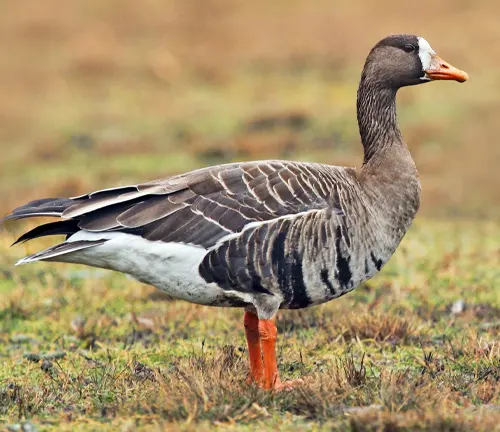
During winter, they embark on extensive migrations, traversing thousands of miles along well-established flyways to reach their wintering grounds in warmer regions such as grasslands and coastal estuaries. Greater White-fronted Geese play a crucial role in ecosystem dynamics, primarily feeding on plant matter like grasses, sedges, and grains. Their grazing activities contribute to habitat maintenance and support a rich diversity of flora and fauna. These geese form monogamous pairs during the breeding season and construct nests on the ground in secluded areas, actively participating in incubation and raising their young.
While the global population of Greater White-fronted Geese appears stable, certain subpopulations face threats from habitat loss, hunting, and climate change. Conservation efforts focus on habitat preservation, regulation of hunting activities, and monitoring population trends to ensure their long-term survival. Overall, the Greater White-fronted Goose stands as a symbol of resilience and adaptability in the face of environmental challenges, captivating the hearts of birdwatchers and conservationists worldwide.
| Specifications | Description |
|---|---|
| Scientific Name | Anser albifrons |
| Common Name | Greater White-fronted Goose |
| Body Color | Brownish-gray with white patches on face |
| Leg Color | Orange |
| Bill Color | Pinkish with black tip |
| Size | Medium to large |
| Habitat | Wetlands, marshes, tundra, agricultural fields |
| Distribution | North America, Europe, Asia |
| Migration | Extensive, thousands of miles annually |
| Feeding Behavior | Primarily plant matter: grasses, sedges, grains |
| Reproduction | Monogamous pairs, ground nests, incubation by both sexes |
| Conservation Status | Stable globally, certain subpopulations threatened |
| Threats | Habitat loss, hunting, climate change |
| Conservation Efforts | Habitat preservation, hunting regulation, population monitoring |
| Significance | Keystone species, ecological contributor, cultural symbol |
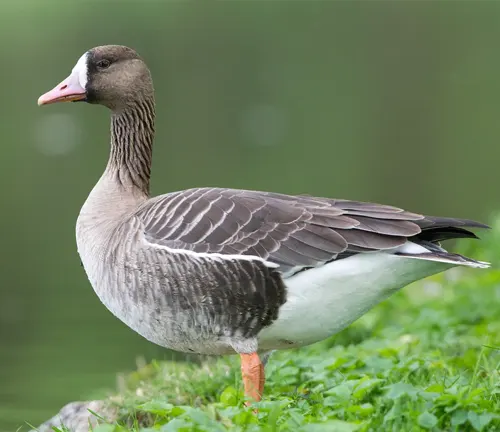
The Greater White-fronted Goose (Anser albifrons) is a fascinating bird species that captivates birdwatchers and scientists alike with its remarkable characteristics and behaviors. In this article, we delve into the intriguing world of the Greater White-fronted Goose, exploring its physical attributes, habitat, migration patterns, feeding behavior, reproductive habits, conservation status, and much more.
Physical Description
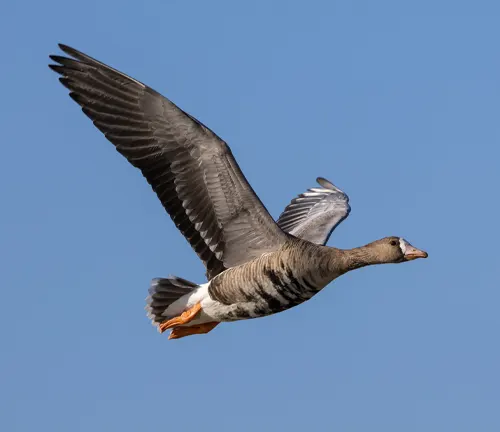
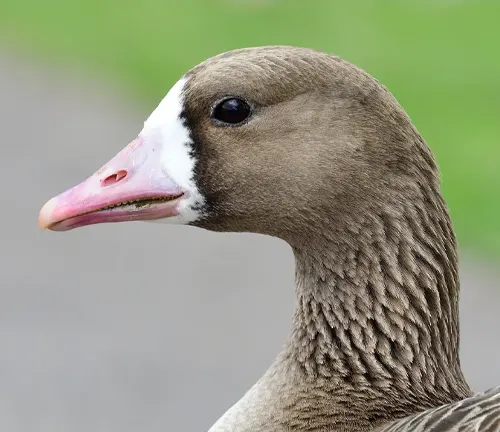
The Greater White-fronted Goose is a medium to large-sized waterfowl species with a distinctive appearance. It has a brownish-gray body with white patches on its face surrounding the bill, giving it a characteristic “white-fronted” appearance. The legs of the goose are typically orange in color, and its bill is pinkish with a black tip. Juveniles often have less prominent markings compared to adults. Overall, the Greater White-fronted Goose presents a striking sight with its unique coloration and features.
Habitat and Distribution
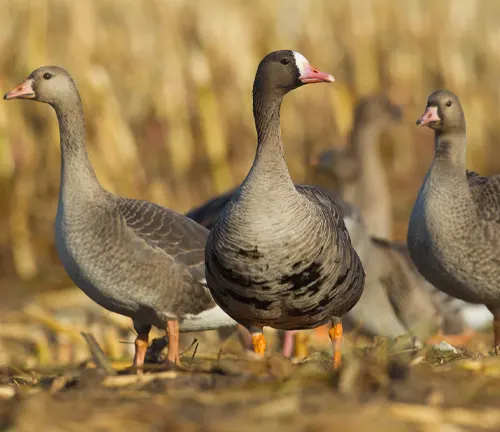
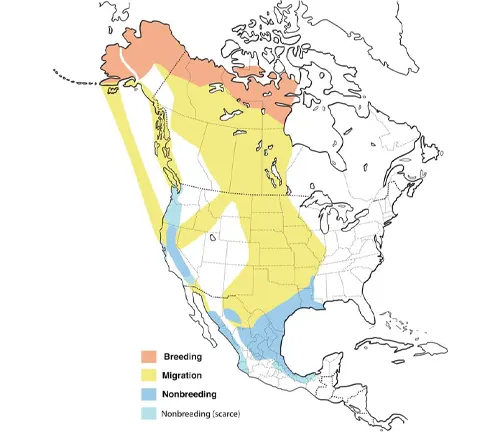
The Greater White-fronted Goose inhabits a diverse range of habitats across its extensive geographical distribution. These habitats include wetlands, marshes, tundra, and agricultural fields. During the breeding season, which occurs in the summer months, they prefer nesting in the Arctic and subarctic regions where suitable nesting sites are available. These areas provide ample vegetation cover and access to water bodies, which are essential for nesting and raising their young.
In terms of distribution, the Greater White-fronted Goose is found across North America, Europe, and Asia. In North America, they breed in Alaska and parts of northern Canada, while in Europe, they breed in northern regions such as Scandinavia and western Siberia. In Asia, their breeding range extends across Siberia and parts of Russia. During the winter months, Greater White-fronted Geese migrate to warmer regions, including grasslands, coastal estuaries, and agricultural lands, where they can find suitable feeding grounds and milder climates. Their migratory routes often follow well-established flyways, and they utilize stopover sites along their journey to rest and refuel.
Migration Patterns
The migration patterns of the Greater White-fronted Goose are truly remarkable and play a significant role in their life cycle. These geese undertake extensive migratory journeys, traveling thousands of miles between their breeding and wintering grounds.
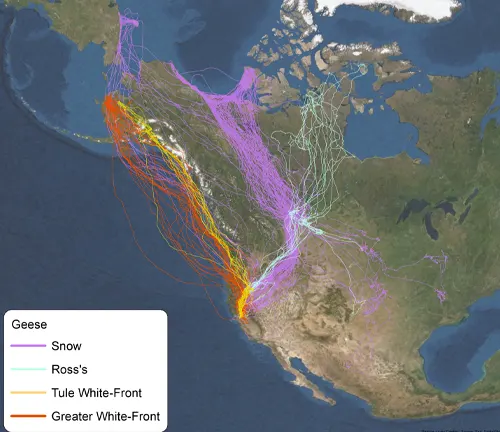
During the breeding season, which typically occurs in the summer months, Greater White-fronted Geese nest in the Arctic and subarctic regions of North America, Europe, and Asia. They construct nests on the ground in secluded areas, often near water bodies, where they raise their young.
As winter approaches, these geese embark on their migratory journey southward to warmer regions. They form large flocks and follow well-established flyways, utilizing stopover sites along their migration routes to rest and refuel.
In North America, Greater White-fronted Geese migrate along the Pacific and Central Flyways, often making stopovers in areas such as the Central Valley of California and the coastal marshes of Louisiana. In Europe and Asia, their migration routes may vary but generally follow similar patterns of moving from northern breeding grounds to southern wintering areas.
Feeding Behavior

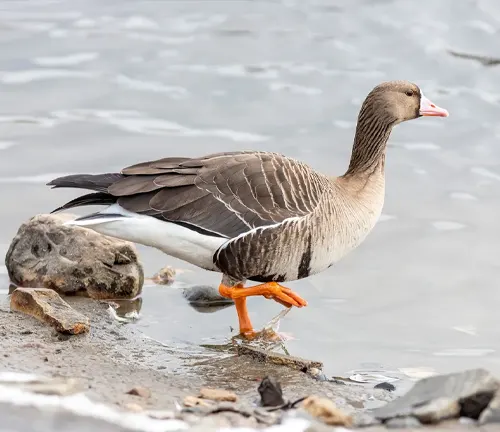
The feeding behavior of the Greater White-fronted Goose is primarily herbivorous, with a diet consisting mainly of plant matter. These geese are known to feed on a variety of vegetation, including grasses, sedges, grains, and agricultural crops.
During the breeding season, when they inhabit wetlands, marshes, and tundra regions, Greater White-fronted Geese graze on a diverse array of plant species found in these habitats. They forage by grazing on the grasses and sedges that grow abundantly in these areas, using their bill to pluck vegetation from the ground or shallow water.
In wintering areas, such as grasslands, coastal estuaries, and agricultural lands, Greater White-fronted Geese may feed on a wider range of plant resources, including agricultural crops such as wheat, barley, and rice. They are often seen foraging in fields and pastures, where they can find an abundance of food to sustain them during the colder months.
Greater White-fronted Geese play an important ecological role as herbivores, contributing to the dynamics of the ecosystems they inhabit. Their grazing activities help maintain the health and diversity of wetland habitats by controlling vegetation growth and creating open spaces for other species. Additionally, their feeding behavior can influence nutrient cycling and soil health in these environments.
Reproduction
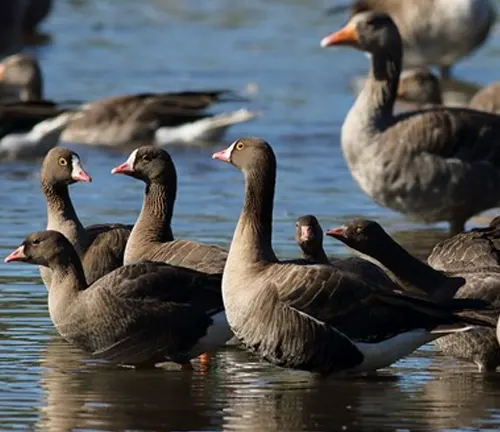
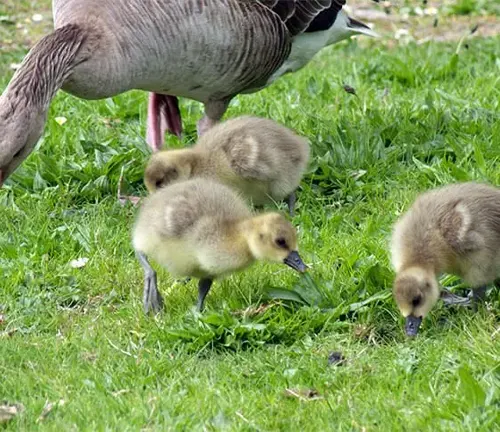
Reproduction in Greater White-fronted Geese typically occurs during the summer months in their breeding grounds, which are primarily located in the Arctic and subarctic regions of North America, Europe, and Asia. These geese exhibit monogamous mating behavior, forming pairs that remain together throughout the breeding season.
Once paired, Greater White-fronted Geese construct their nests on the ground in secluded areas, often near water bodies such as lakes, ponds, or marshes. The female selects a nest site and builds a shallow depression lined with plant material, feathers, and down to provide insulation and protection for the eggs.
The female then lays a clutch of eggs, typically numbering 4 to 6 eggs, although clutch sizes can vary. Both the male and female take turns incubating the eggs, with each partner sharing responsibility for keeping the eggs warm and protected from predators. Incubation lasts for about 25 to 28 days, after which the eggs hatch, usually within a few days of each other.
Once the eggs hatch, the parents continue to care for their young, known as goslings. They provide warmth, protection, and guidance to the goslings, leading them to suitable foraging areas and teaching them essential skills such as feeding and avoiding predators.
Conservation Status
The conservation status of the Greater White-fronted Goose varies depending on the specific populations and regions. Overall, the species is considered to have a stable global population, but certain subpopulations face conservation concerns and are monitored closely by conservation organizations.

In North America, the Greater White-fronted Goose is managed as a game species, and hunting regulations are in place to ensure sustainable harvest levels. However, habitat loss and degradation, particularly of wetland habitats and breeding grounds, pose ongoing threats to some populations. Climate change is also a concern, as it can affect the availability of suitable breeding and wintering habitats and alter migration patterns.
In Europe and Asia, similar conservation challenges exist, including habitat loss, hunting pressure, and disturbances to breeding and wintering areas. Efforts to conserve the species in these regions include habitat restoration projects, conservation of key breeding and stopover sites, and research on migration ecology and population dynamics.
Conservation initiatives for the Greater White-fronted Goose also involve international collaboration, as the species migrates across multiple countries and continents. Cooperation between governments, conservation organizations, and local communities is essential to address the complex conservation issues facing this species and ensure its long-term survival.
Interaction with Humans
The interaction between Greater White-fronted Geese and humans is multifaceted, influenced by factors such as habitat use, agricultural practices, and conservation efforts.
In some regions, Greater White-fronted Geese are valued for their role in ecotourism, attracting birdwatchers and wildlife enthusiasts who seek to observe these majestic birds in their natural habitats. Their presence contributes to local economies through activities such as birdwatching tours, wildlife photography, and nature-based tourism.
However, conflicts can arise between Greater White-fronted Geese and humans, particularly in agricultural areas where geese may cause crop damage. Feeding on agricultural crops such as wheat, barley, and rice can lead to financial losses for farmers and agricultural producers. In response, measures such as scare tactics, habitat modification, and hunting permits may be implemented to manage goose populations and mitigate conflicts.
Cultural Significance
The Greater White-fronted Goose holds cultural significance in various societies and has been intertwined with human history and folklore for centuries. Across different cultures, these geese have been depicted in art, literature, and traditional ceremonies, symbolizing different meanings and values.
In folklore and literature, geese, including the Greater White-fronted Goose, are often portrayed as symbols of loyalty, family, and wilderness. They appear in myths, fables, and folktales as characters representing qualities such as resilience, perseverance, and freedom. Their migratory journeys and seasonal patterns have inspired stories and legends, reflecting the natural world’s rhythms and cycles.
Indigenous peoples have also incorporated geese into their traditions and ceremonies, viewing them as sacred animals with spiritual significance. In some cultures, geese are revered as messengers of the divine or guardians of the natural world, with rituals and rituals performed to honor and respect their presence.
Challenges and Threats
The Greater White-fronted Goose faces various challenges and threats that affect its population and habitat across its range. These challenges include:
- Habitat Loss and Degradation: The conversion of wetlands, marshes, and tundra habitats for agriculture, urban development, and infrastructure projects reduces available nesting and feeding grounds for Greater White-fronted Geese.
- Climate Change: Climate variability and change can alter the timing of migration, availability of suitable breeding and wintering habitats, and food resources for geese, impacting their survival and reproductive success.
- Hunting Pressure: While regulated hunting of Greater White-fronted Geese is permitted in some regions, illegal hunting and poaching can pose significant threats to populations, particularly during migration and wintering periods.
- Pollution: Pollution from agricultural runoff, industrial activities, and human settlements can contaminate water bodies and wetland habitats, affecting water quality and food resources for Greater White-fronted Geese.
- Disturbance: Human activities such as recreational activities, urbanization, and infrastructure development can disrupt nesting, feeding, and migration behaviors of Greater White-fronted Geese, leading to stress and displacement.
- Predation: Predators such as foxes, coyotes, eagles, and ravens can prey on eggs, goslings, and adult geese, particularly in vulnerable nesting sites and during migration stopovers.
- Disease: Outbreaks of diseases such as avian influenza and avian cholera can impact Greater White-fronted Goose populations, leading to mortality and population declines.
- Agricultural Conflicts: Greater White-fronted Geese may feed on agricultural crops such as wheat, barley, and rice, leading to conflicts with farmers and agricultural producers and resulting in crop damage and financial losses.
Different Species
Anser albifrons albifrons
This subspecies breeds in the tundra regions of Eurasia, particularly in northern Europe and western Siberia. It has a broad white forehead and bright orange legs.
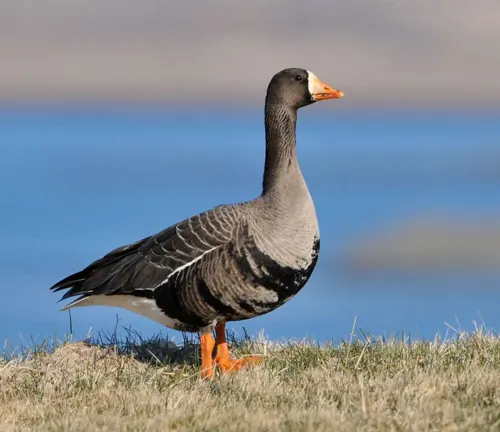
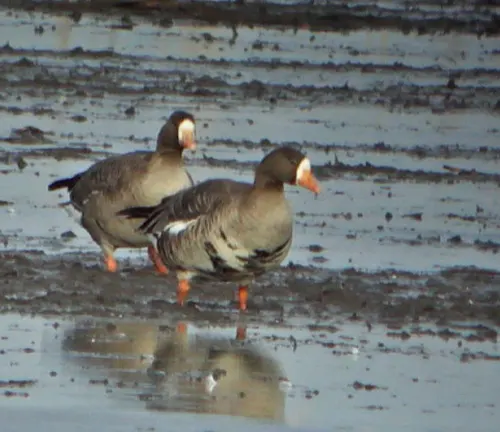
Anser albifrons gambeli
Found in North America, specifically in Alaska and western Canada, this subspecies is slightly larger than the nominate subspecies. It has a darker overall plumage and a narrower white forehead.
Anser albifrons frontalis
Breeding in eastern Siberia, this subspecies has a smaller population size compared to others. It has a distinctively dark brown coloration and a narrow white forehead.

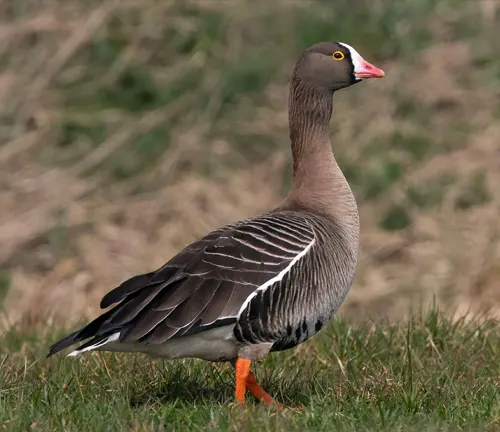
Anser albifrons elgasi
Inhabiting the western Aleutian Islands of Alaska, this subspecies is isolated from the mainland populations. It has a paler plumage and a broader white forehead compared to other North American subspecies.
Frequently Asked Questions (FAQs)
- Where can I see Greater White-fronted Geese?
These geese can be found in a variety of habitats, including wetlands, marshes, tundra, and agricultural fields, depending on the season and geographical location. - How long do Greater White-fronted Geese live?
On average, Greater White-fronted Geese have a lifespan of around 10 to 15 years in the wild. - Do Greater White-fronted Geese migrate in flocks?
Yes, these geese typically migrate in large flocks, often numbering in the thousands, which provides them with safety and efficiency during their long journeys. - Are Greater White-fronted Geese noisy?
Yes, they are known for their vocalizations, which include a variety of honking and cackling sounds used for communication within the flock. - Do Greater White-fronted Geese have predators?
Yes, they face predation from various predators, including foxes, coyotes, eagles, and ravens, especially during nesting and migration. - How do Greater White-fronted Geese communicate?
They communicate through a combination of vocalizations, body language, and visual cues, which help coordinate behaviors such as feeding, mating, and navigating during migration. - How do Greater White-fronted Geese protect themselves from predators?
They rely on vigilance, flocking behavior, and alarm calls to alert others of potential threats. Additionally, they may take flight or seek refuge in water bodies to evade predators. - What is the breeding season of Greater White-fronted Geese?
Breeding typically occurs during the summer months in the Arctic and subarctic regions, with nesting and chick-rearing taking place in secluded areas away from predators. - Do Greater White-fronted Geese return to the same nesting sites every year?
While they may exhibit site fidelity to some extent, factors such as habitat quality and environmental conditions influence their choice of nesting sites each breeding season. - Are Greater White-fronted Geese monogamous?
Yes, they typically form monogamous pairs during the breeding season and remain together to raise their offspring. - What is the role of Greater White-fronted Geese in the ecosystem?
These geese play a crucial role in ecosystem dynamics by grazing on vegetation, which helps maintain habitat diversity, nutrient cycling, and ecosystem health. - How do Greater White-fronted Geese adapt to changing environmental conditions?
They exhibit behavioral flexibility and may adjust their migration routes, breeding locations, and feeding habits in response to environmental changes, including climate variability and habitat disturbance.


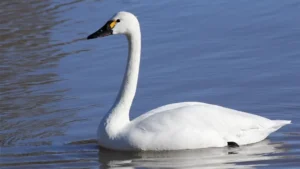
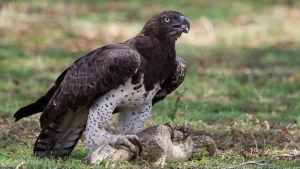
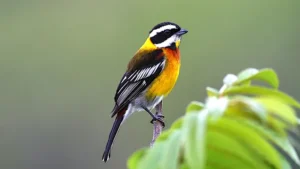
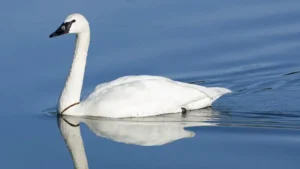

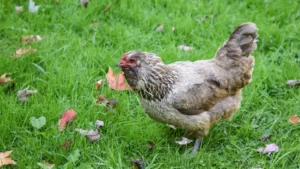
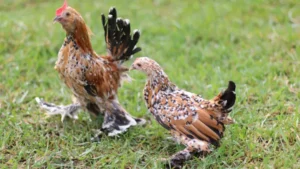
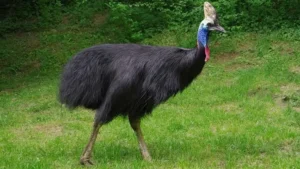

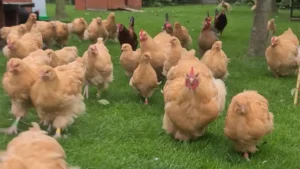
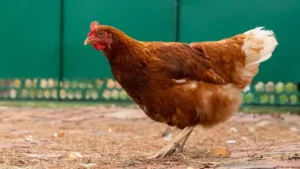
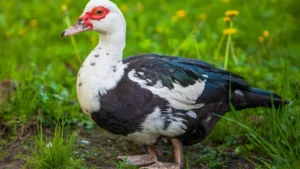
Leave your comment